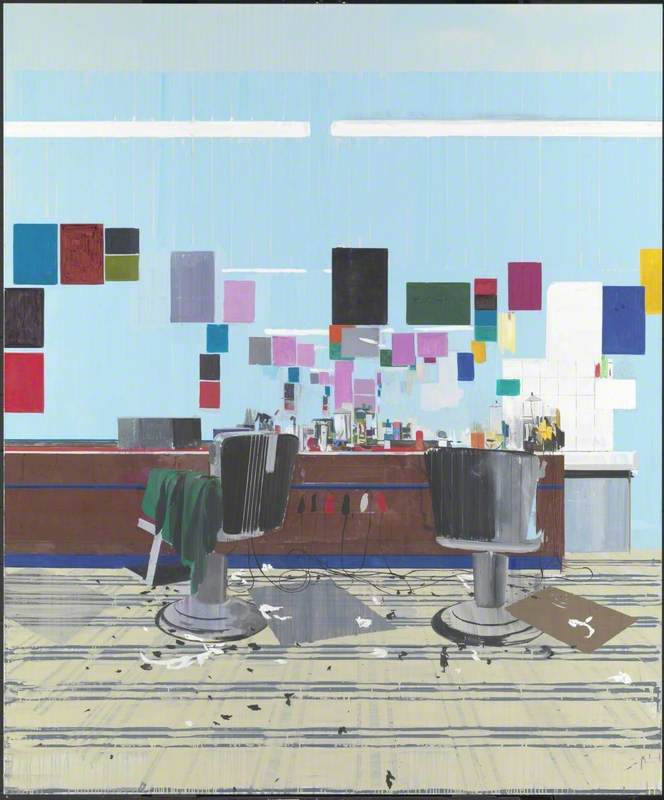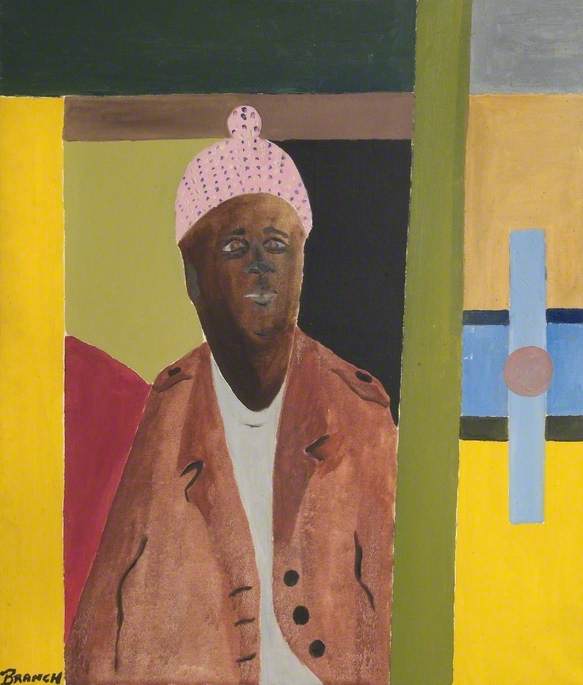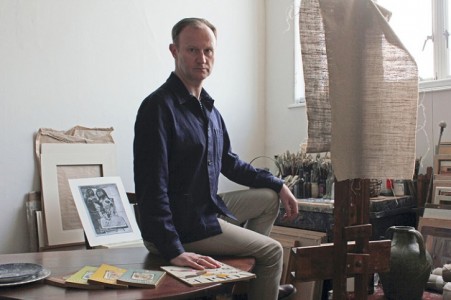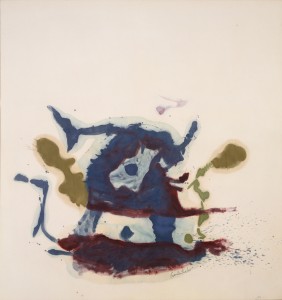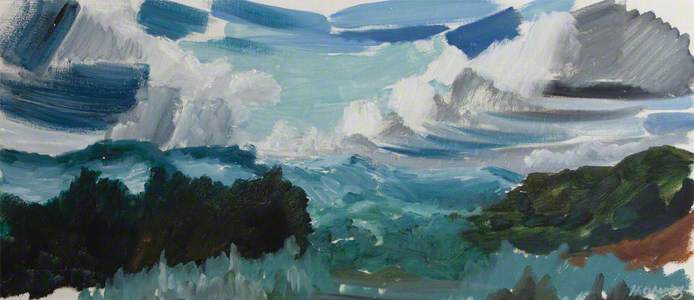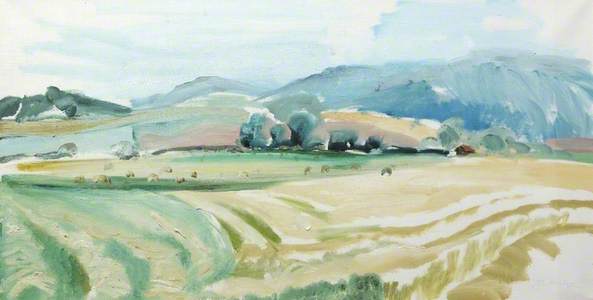The position of artists with famous artist fathers is often a complicated one. If you paint like your dad, you're just a follower; if you don't, you probably won't please his admirers.
The best solution is when it's clear in your work that you, inevitably, owe a lot to your father's influence, but are nevertheless managing to say something else, something new and individual. Then the lineage makes sense but your unique artistic character is also evident. This is the situation John Hitchens (b.1940), a youthful 80-year-old, currently finds himself in when he looks back over a lifetime of varied and distinguished achievement.
John Hitchens in his Sussex studio, July 2015
photograph 
Take a look at the 14 works listed on the Art UK website: they are all landscapes, and almost all date from the 1950s and 1960s. They are mostly very direct studies of countryside, either made on the spot or from observation in front of nature.
Particularly lyrical are Landscape: Heather and Water (c.1963); Blue Hills and Heather; September Hills (1959); and South Downs Panorama, Treyford (1963).
In these lovely fresh paintings, John Hitchens' acute powers of observation are evident, as is his ability to find an equivalent for what he has seen in spontaneous, unfussy paint.
Two of the paintings on Art UK show him at his closest to his father's work, with large, almost billowy forms of succinct colour, brushily achieved.
Birds and Ferns and Flowers in a Shore Window (1968) are about signs and essences. More abstract than John Hitchens' observational work, they demonstrate a search for underlying forms and colours shared with his father's approach.
But there the resemblance ends, because neither painting could be mistaken for an Ivon Hitchens (1893–1979) by anyone with any familiarity with the older artist's work. John Hitchens has his own distinct approach to pictorial construction, his own particular palette, and his own painterly 'handwriting'.
When I first saw John Hitchens' work, in an exhibition in Chichester in the 1970s, I made the mistake of underestimating it – thinking he was nothing but a pale imitation of his father. I should have been looking for the differences, not the similarities.
I confess that after that I rather lost sight of what he was doing, apart from occasional reports that he was making very different work that some people were comparing to Indigenous Australian painting. And then a recent visit to his studio, made while curating an exhibition of his father's paintings ('Ivon Hitchens: Painter in the Woods', held at the Garden Museum in London, May–July 2019), made me utterly rethink my assumptions.
Sometimes an artist's work makes most sense in the context of the studio, particularly when there's plenty of work from all periods in evidence. A unifying character or personality emerges as you look. This was the case with John Hitchens. I was overwhelmed by his work in all its diversity when experienced at close quarters.
I was particularly beguiled by his need to explore different forms of expression, from painting to sculpture and photography, depending on what he wanted to say. Landscape, as you might expect, remains fundamental to his approach, but it is interpreted in countless original ways, with a richness of outcome that is often unexpected.
A sense of the breadth and variety of John Hitchens' achievement is communicated by the retrospective he put together for Southampton City Art Gallery. Intended to run from March to late June this year, it was sadly interrupted by the depredations of the coronavirus, which has closed all public galleries and forced many visitors to go online for their fix of art, or resort to books and catalogues. As a writer of books myself, I welcome this, while lamenting the necessity for gallery closures.
In the brochure accompanying the exhibition, examples of all periods of his work are illustrated. However, his own interest in his latest work (and which artist doesn't love his current work above his earlier?) is evident from the fact that the show commenced with recent landscapes, and an aerial fieldscape, Field Boundaries, is illustrated on the brochure's cover.
Here linear pattern is the order of the day, with dots and lines indicating stubble, post-holes in the ground and field paths. Contour lines and land boundaries are evoked as seen from the air, but the whole arrangement has a pattern and sweep that is almost symphonic in its layout and extent.
Field Boundaries
2000, oil on canvas by John Hitchens (b.1940) 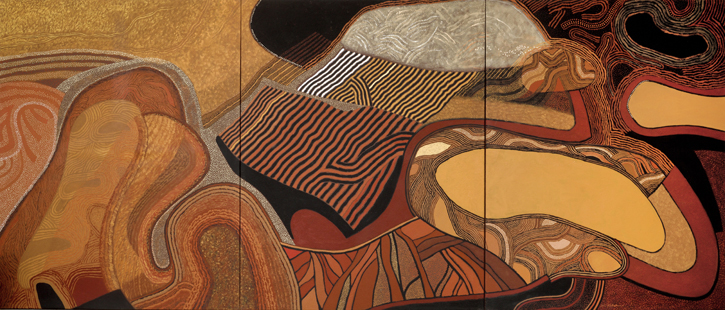
Like the Nicholsons and the Pipers, the Hitchens are a distinguished artistic dynasty, and there are now four generations of Hitchens on Art UK: Alfred, Ivon, John and now John's son Simon, a sculptor. That history of achievement provides a wonderful common ground of family work, however varied the expressions of it may be. It offers a resonance that other artists, less genealogically blessed, simply don't have.
Ben Nicholson's father William was a painter, as are several of his offspring. Likewise, both John Piper (1903–1992) and Terry Frost (1925–2003) have founded artist-dynasties, extending now into a third generation. I make no attempt to explain this other than to say that it works for some, but obviously not for many. Long may the Hitchens family thrive and continue to create.
Andrew Lambirth, writer, critic, curator
Andrew has recently published John Nash: Artist and Countryman, and The Life of Bryan: A Celebration of Bryan Robertson, available from Unicorn Press. For a more detailed analysis of John Hitchens' paintings see the magnificent new monograph on his work Aspects of Landscape, by various authors, published by Sansom & Co.






















